Collector Didier Hanson has sent me again scans of very old and rare film postcards from 'Mother Russia'. On 12 October and 19 February we already posted Didier's postcards of such silent stars as Vera Kholodnaya, Vera Karalli, Nathalie Kovanko, Vitold Polonsky and Ivan Khudoleyev. So, I am delighted to present you another post on the artists of the Russian theatre and cinema from the times of the last Czar.
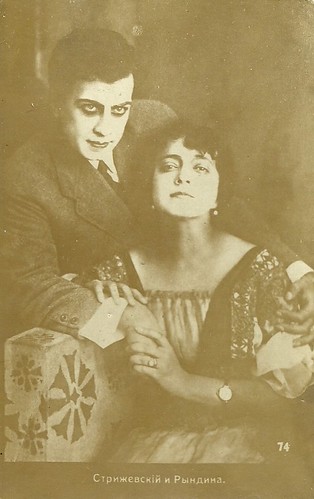
Vladimir Strizhevsky and Lidiya F. Ryndina. Russian postcard, no. 74. Collection: Didier Hanson.
Russian director an actor Vladimir Strizhevsky worked in Russia, Germany and France. In 1915, Strizhevsky started to act in silent Russian films like Sashka-Seminarist (Cheslav Sabinsky, 1915), and Teni grekha (Pyotr Chardynin, 1915) with Vera Karalli. With director Yevgeni Bauer he made Grif starogo bortsa/Griffon of an Old Warrior (Yevgeni Bauer, 1916) also with Karalli, Nabat/The Alarm (Yevgeni Bauer, 1917) and Revolyutsioner/Revolutionary (Yevgeni Bauer, 1917). In Zhizn trekh dney/A life of three days (Gromov, 1917) , his co-star was Lidiya F. Ryndina (1884-1957).
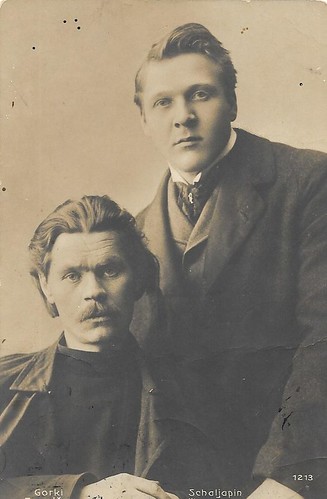
Maxim Gorky and Feodor Chaliapin. Russian postcard, no. 1213. Collection: Didier Hanson.
Maksim Gorky or Maxim Gorki was the pseudonym of Aleksey Maksimovich Peshkov (1868-1936). The Russian short-story writer and novelist first attracted attention with his naturalistic and sympathetic stories of tramps and social outcasts and later wrote other stories, novels, and plays, including his famous Na dne/The Lower Depths (1902). Mat/Mother (1906) is probably the least successful of his novels, yet it has considerable interest as Gorky’s only long work devoted to the Russian revolutionary movement. It was made into a notable silent film by Vsevolod Pudovkin (1926).
Feodor Ivanovich Chaliapin (Russian: Фёдор Ива́нович Шаля́пин) (1873–1938) was a Russian opera singer. The possessor of a large, deep and expressive bass voice, he enjoyed an important international career at major opera houses and is often credited with establishing the tradition of naturalistic acting in his chosen art form. His emigration from Russia in 1922, was painful. Soviet government stripped Chaliapin of all his titles and honours. He settled in Paris, France. There he performed at the Paris Opera, as well as at numerous private concerts for Sergei Diaghilev. His acting and singing was sensational. He made many sound recordings between the 1900 and 1938, of which the 1913 recordings of the Russian folk songs Vdol po Piterskoi and The Song of the Volga Boatmen are best known. The only sound film which shows his acting style is Don Quixote (Georg Wilhelm Pabst, 1933). Chaliapin collaborated with Maxim Gorky, who wrote and edited his memoirs, which he published in 1933.
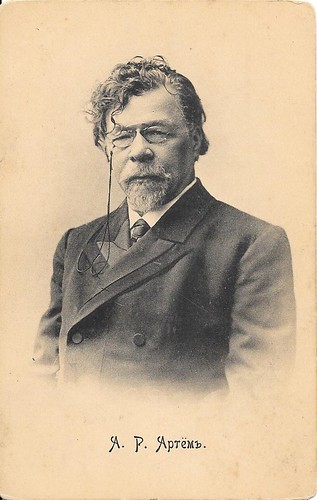
Aleksandr R. Artem. Russian postcard. Collection: Didier Hanson.
Russian actor A. R. Artem (1842–1914) came late, in his forties, to the theatre, after a career as a visual artist. He became one of the star actors of the Moscow Art Theatre (MXAT) where he was noted as a character actor in the plays by Chekov, Gurky and Turgenev. Anton Chekhov mentioned him as his favourite actor.
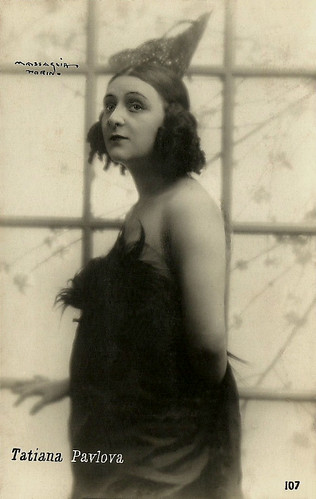
Tatiana Pavlova. Italian postcard, no. 107. Photo: Ercole Massaglia, Torino. Collection: Didier Hanson.
Russian actress Tatiana (or Tatyana) Pavlova (1893-1975) first worked in the touring company of Pavel Orlenev and later in Moscow theatres. She made her Moscow debut in 1916 in the lead role of Fröken Julie/Miss Julie by August Strindberg. Following the revolution, she abandoned Moscow and worked in Paris, Odessa and Constantinople. In 1919 she went to Italy where she participated in silent films of the Ambrosio studio like La catena/The Chain (Alessandro Rosenfeld, Aleksandr Uralsky, 1920) with Ossip Runitsch. It was followed by other films by Rosenfeld and Uralsky, like L'Orchidea fatale (1920) again with Ossip Runitsch.

Ossip Runitsch. Russian postcard. Collection: Didier Hanson.
Russian actor, producer and stage director Ossip Runitsch (1889-1947) was one of the biggest stars of Russian silent cinema and one of the first iconic figures of Russian cinematograph.
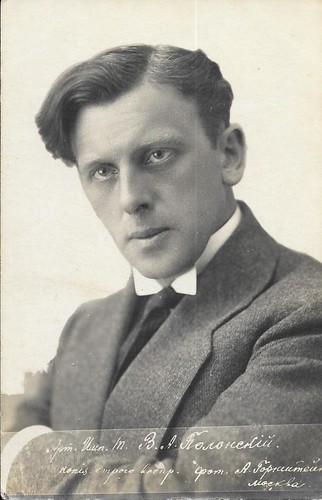
Vitold Polonsky. Russian postcard. Collection: Didier Hanson.
Vitold Polonsky (1879-1919) was one of the most popular actors in pre-Revolutionary Russian cinema.
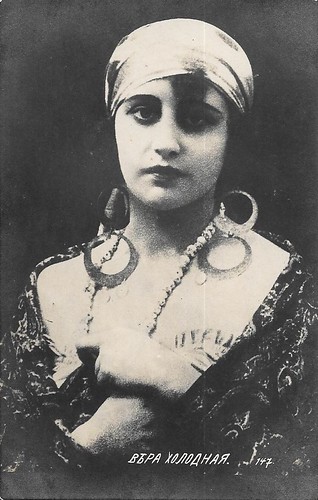
Vera Kholodnaya. Russian postcard, no. 147. Collection: Didier Hanson.
Vera Kholodnaya (1893-1919) was the first star of the Russian silent cinema. Only 26, the ‘Queen of Screen’ died of the Spanish flu during the pandemic of 1919. Although she worked only three years for the cinema, she must have made between fifty and hundred short films. The Soviet authorities ordered to destroy many of the Kholodnaya features in 1924, and only five of her films still exist.

Vera Karalli. Russian postcard. Photo: publicity still for Krizantemy/Chrysanthemums (Pyotr Chardynin, 1914). Collection: Didier Hanson.
Vera Karalli (1889-1972) was a Russian ballet dancer, choreographer and actress in the early 20th century.
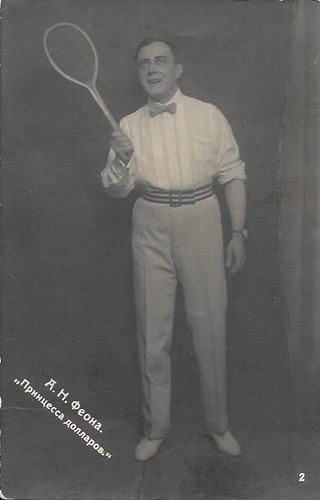
Aleksei Feona. Russian postcard. Collection: Didier Hanson.
Russian actor A.N. Feona starred in A Doll's House by Henrik Ibsen, when Mme. Vera F. Komisarzhevskaya Repertory performed the famous play on Broadway in March 1908. During the 1920s, he played in two Soviet films, Poet i tsar/The Poet and the Czar (Vladimir Gardin, Yevgeni Chervyakov, 1927) and Kastus Kalinovskiy (Vladimir Gardin, 1928).
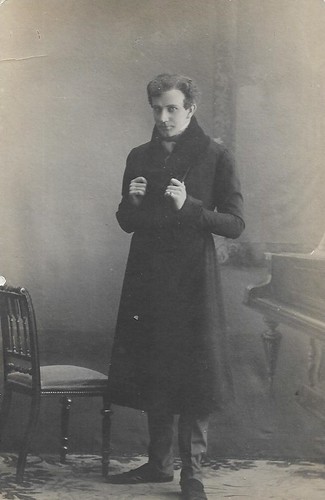
Vasily Kachalov. Russian postcard. Collection: Didier Hanson.
Russian film and stage actor Vasily Kachalov (1875-1948) was one of Konstantin Stanislavsky's best known performers. He led the so-called Kachalov Group within the Moscow Art Theatre. He also appeared in four films.
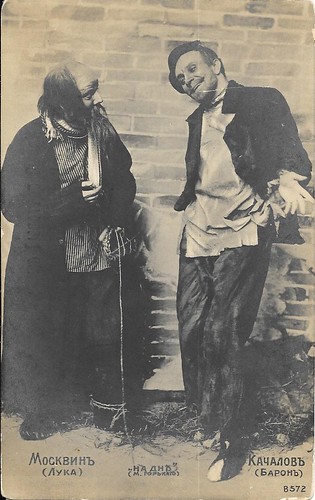
Ivan Moskvin and Vasily Kachalov in The Lower Depths (1902). Russian postcard, no. 8572. Photo: publicity still for the Moscow Art Theatre production of The Lower Depths (1902) by Maxim Gorky, with Ivan Moskvin as Luka and Vasily Kachalov as the Baron. Collection: Didier Hanson.

Vasily Kachalov as Hamlet. Russian postcard. Photo: publicity still for The Moscow Art Theatre (MAT) production of Hamlet in 1911–1912. Collection: Didier Hanson.
Kachalov played Hamlet in the Symbolist production of 1911, created by two of the 20th century's most influential theatre practitioners—Konstantin Stanislavski and Edward Gordon Craig. Craig was an English theatre practitioner who had garnered interest for the symbolist and simplistic designs he brought to plays like Henrik Ibsen’s The Vikings at Helgeland. Konstantin Stanislavski was creating a world of theatre based upon realism, the internal complexities of the mind, and the rise of psychology. Their cooperation eventually gave birth to one of the most unique, polarizing, and impactful productions of all the twentieth century. Despite hostile reviews from the Russian press, the production attracted enthusiastic and unprecedented worldwide attention for the theatre, with reviews in Britain's The Times and in the French press that praised its unqualified success; the production placed the Moscow Art Theatre on the cultural map for Western Europe and it came to be regarded as a seminal event that influenced the subsequent history of production style in the theatre and revolutionised the staging of Shakespeare's plays in the 20th century. It became one of the most famous and passionately discussed productions in the history of the modern stage.
Didier, thank you.

Vladimir Strizhevsky and Lidiya F. Ryndina. Russian postcard, no. 74. Collection: Didier Hanson.
Russian director an actor Vladimir Strizhevsky worked in Russia, Germany and France. In 1915, Strizhevsky started to act in silent Russian films like Sashka-Seminarist (Cheslav Sabinsky, 1915), and Teni grekha (Pyotr Chardynin, 1915) with Vera Karalli. With director Yevgeni Bauer he made Grif starogo bortsa/Griffon of an Old Warrior (Yevgeni Bauer, 1916) also with Karalli, Nabat/The Alarm (Yevgeni Bauer, 1917) and Revolyutsioner/Revolutionary (Yevgeni Bauer, 1917). In Zhizn trekh dney/A life of three days (Gromov, 1917) , his co-star was Lidiya F. Ryndina (1884-1957).

Maxim Gorky and Feodor Chaliapin. Russian postcard, no. 1213. Collection: Didier Hanson.
Maksim Gorky or Maxim Gorki was the pseudonym of Aleksey Maksimovich Peshkov (1868-1936). The Russian short-story writer and novelist first attracted attention with his naturalistic and sympathetic stories of tramps and social outcasts and later wrote other stories, novels, and plays, including his famous Na dne/The Lower Depths (1902). Mat/Mother (1906) is probably the least successful of his novels, yet it has considerable interest as Gorky’s only long work devoted to the Russian revolutionary movement. It was made into a notable silent film by Vsevolod Pudovkin (1926).
Feodor Ivanovich Chaliapin (Russian: Фёдор Ива́нович Шаля́пин) (1873–1938) was a Russian opera singer. The possessor of a large, deep and expressive bass voice, he enjoyed an important international career at major opera houses and is often credited with establishing the tradition of naturalistic acting in his chosen art form. His emigration from Russia in 1922, was painful. Soviet government stripped Chaliapin of all his titles and honours. He settled in Paris, France. There he performed at the Paris Opera, as well as at numerous private concerts for Sergei Diaghilev. His acting and singing was sensational. He made many sound recordings between the 1900 and 1938, of which the 1913 recordings of the Russian folk songs Vdol po Piterskoi and The Song of the Volga Boatmen are best known. The only sound film which shows his acting style is Don Quixote (Georg Wilhelm Pabst, 1933). Chaliapin collaborated with Maxim Gorky, who wrote and edited his memoirs, which he published in 1933.

Aleksandr R. Artem. Russian postcard. Collection: Didier Hanson.
Russian actor A. R. Artem (1842–1914) came late, in his forties, to the theatre, after a career as a visual artist. He became one of the star actors of the Moscow Art Theatre (MXAT) where he was noted as a character actor in the plays by Chekov, Gurky and Turgenev. Anton Chekhov mentioned him as his favourite actor.

Tatiana Pavlova. Italian postcard, no. 107. Photo: Ercole Massaglia, Torino. Collection: Didier Hanson.
Russian actress Tatiana (or Tatyana) Pavlova (1893-1975) first worked in the touring company of Pavel Orlenev and later in Moscow theatres. She made her Moscow debut in 1916 in the lead role of Fröken Julie/Miss Julie by August Strindberg. Following the revolution, she abandoned Moscow and worked in Paris, Odessa and Constantinople. In 1919 she went to Italy where she participated in silent films of the Ambrosio studio like La catena/The Chain (Alessandro Rosenfeld, Aleksandr Uralsky, 1920) with Ossip Runitsch. It was followed by other films by Rosenfeld and Uralsky, like L'Orchidea fatale (1920) again with Ossip Runitsch.

Ossip Runitsch. Russian postcard. Collection: Didier Hanson.
Russian actor, producer and stage director Ossip Runitsch (1889-1947) was one of the biggest stars of Russian silent cinema and one of the first iconic figures of Russian cinematograph.

Vitold Polonsky. Russian postcard. Collection: Didier Hanson.
Vitold Polonsky (1879-1919) was one of the most popular actors in pre-Revolutionary Russian cinema.

Vera Kholodnaya. Russian postcard, no. 147. Collection: Didier Hanson.
Vera Kholodnaya (1893-1919) was the first star of the Russian silent cinema. Only 26, the ‘Queen of Screen’ died of the Spanish flu during the pandemic of 1919. Although she worked only three years for the cinema, she must have made between fifty and hundred short films. The Soviet authorities ordered to destroy many of the Kholodnaya features in 1924, and only five of her films still exist.

Vera Karalli. Russian postcard. Photo: publicity still for Krizantemy/Chrysanthemums (Pyotr Chardynin, 1914). Collection: Didier Hanson.
Vera Karalli (1889-1972) was a Russian ballet dancer, choreographer and actress in the early 20th century.

Aleksei Feona. Russian postcard. Collection: Didier Hanson.
Russian actor A.N. Feona starred in A Doll's House by Henrik Ibsen, when Mme. Vera F. Komisarzhevskaya Repertory performed the famous play on Broadway in March 1908. During the 1920s, he played in two Soviet films, Poet i tsar/The Poet and the Czar (Vladimir Gardin, Yevgeni Chervyakov, 1927) and Kastus Kalinovskiy (Vladimir Gardin, 1928).

Vasily Kachalov. Russian postcard. Collection: Didier Hanson.
Russian film and stage actor Vasily Kachalov (1875-1948) was one of Konstantin Stanislavsky's best known performers. He led the so-called Kachalov Group within the Moscow Art Theatre. He also appeared in four films.

Ivan Moskvin and Vasily Kachalov in The Lower Depths (1902). Russian postcard, no. 8572. Photo: publicity still for the Moscow Art Theatre production of The Lower Depths (1902) by Maxim Gorky, with Ivan Moskvin as Luka and Vasily Kachalov as the Baron. Collection: Didier Hanson.

Vasily Kachalov as Hamlet. Russian postcard. Photo: publicity still for The Moscow Art Theatre (MAT) production of Hamlet in 1911–1912. Collection: Didier Hanson.
Kachalov played Hamlet in the Symbolist production of 1911, created by two of the 20th century's most influential theatre practitioners—Konstantin Stanislavski and Edward Gordon Craig. Craig was an English theatre practitioner who had garnered interest for the symbolist and simplistic designs he brought to plays like Henrik Ibsen’s The Vikings at Helgeland. Konstantin Stanislavski was creating a world of theatre based upon realism, the internal complexities of the mind, and the rise of psychology. Their cooperation eventually gave birth to one of the most unique, polarizing, and impactful productions of all the twentieth century. Despite hostile reviews from the Russian press, the production attracted enthusiastic and unprecedented worldwide attention for the theatre, with reviews in Britain's The Times and in the French press that praised its unqualified success; the production placed the Moscow Art Theatre on the cultural map for Western Europe and it came to be regarded as a seminal event that influenced the subsequent history of production style in the theatre and revolutionised the staging of Shakespeare's plays in the 20th century. It became one of the most famous and passionately discussed productions in the history of the modern stage.
Didier, thank you.
2 comments:
Wonderful postcard of Vera Karalli!
That one is very unusual, probably of a ballet scene in the film.
Post a Comment